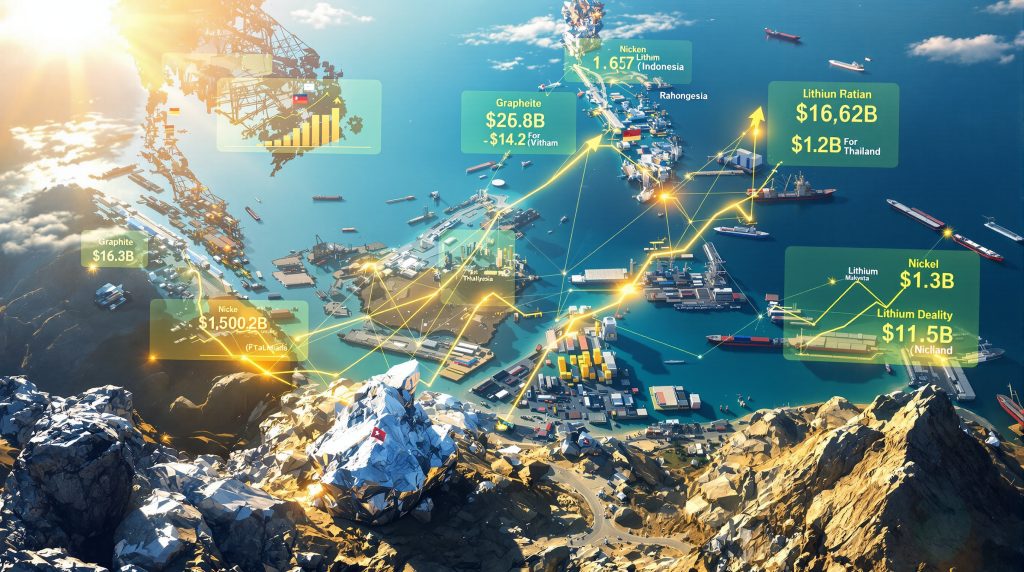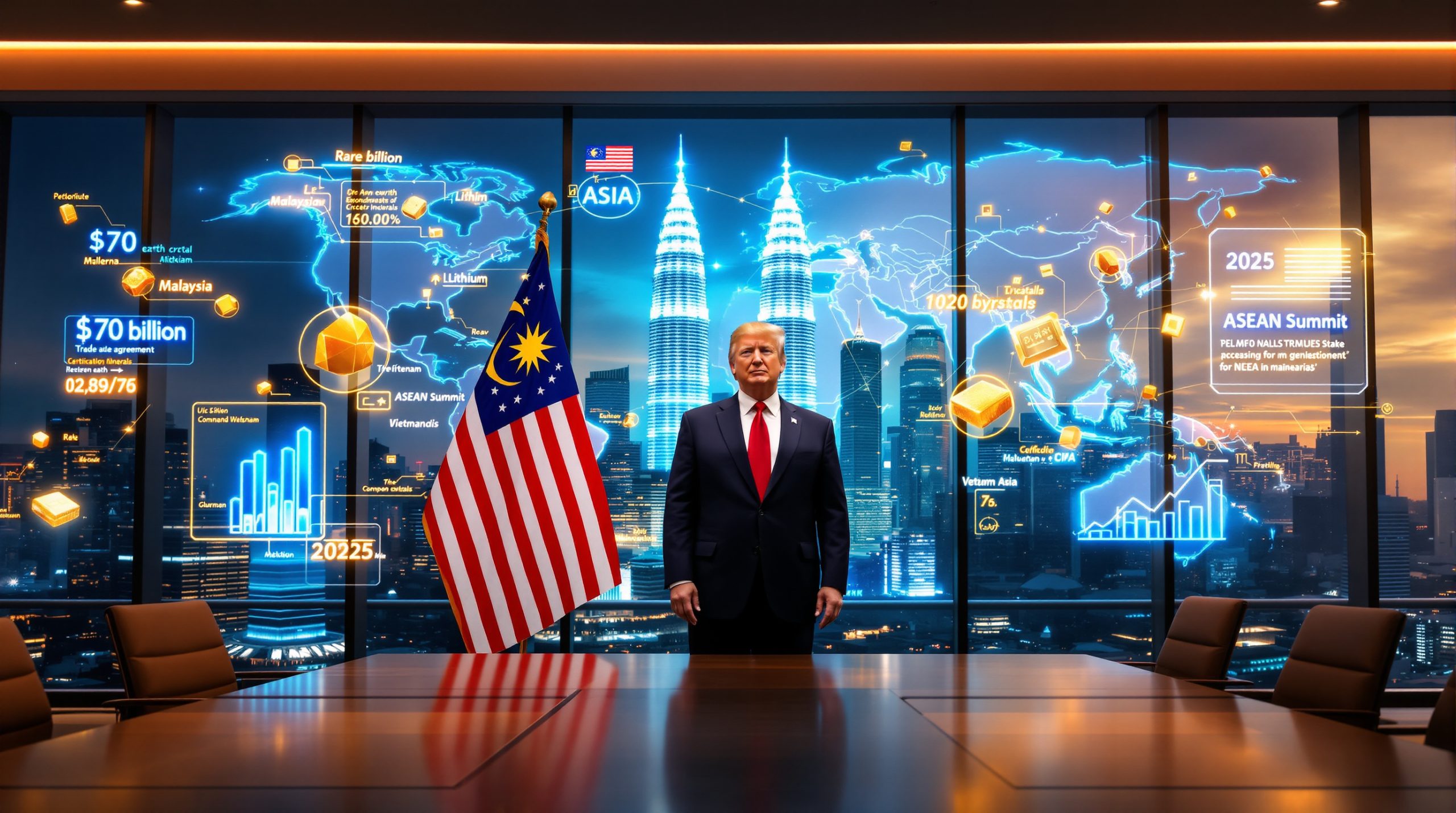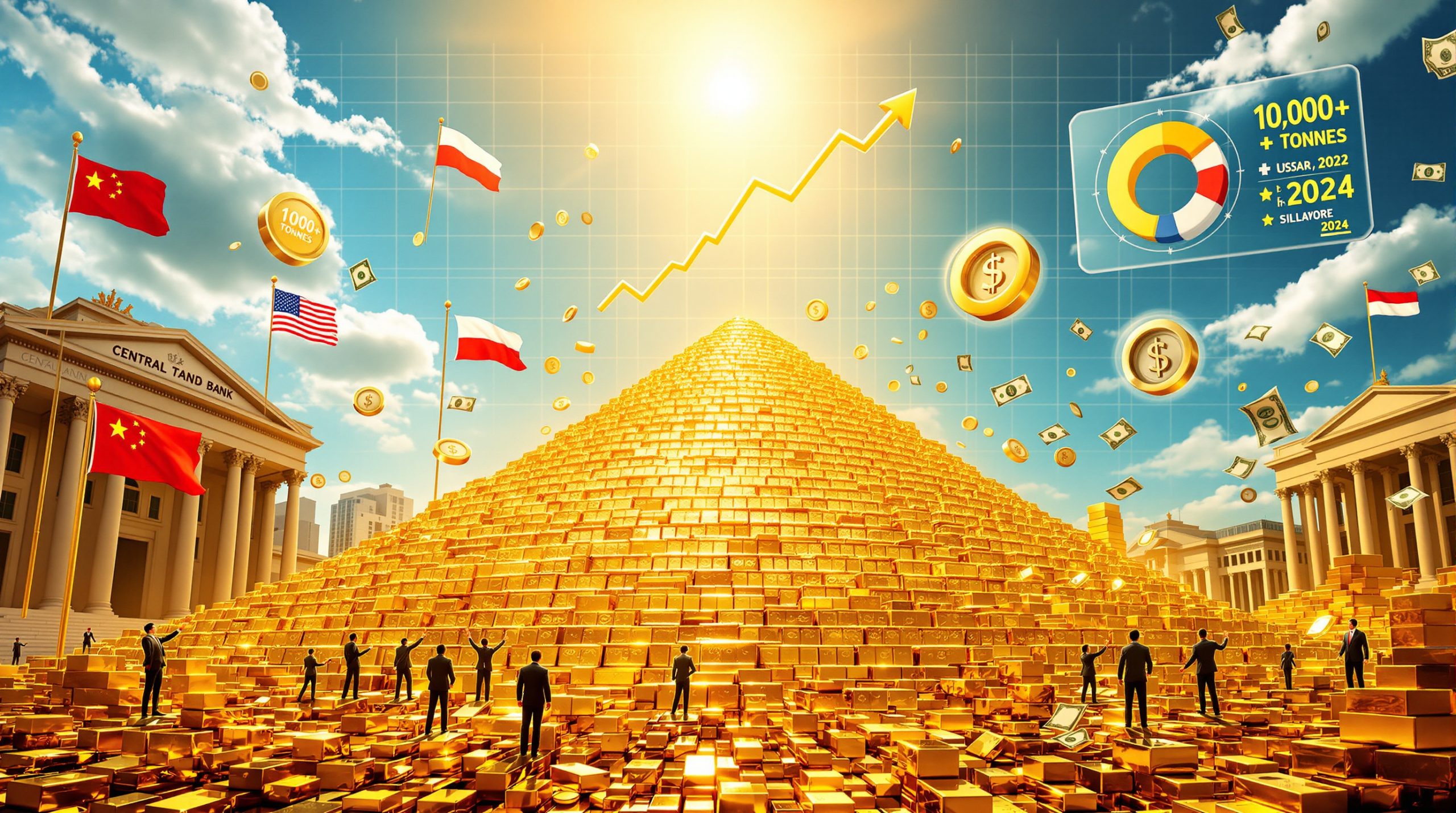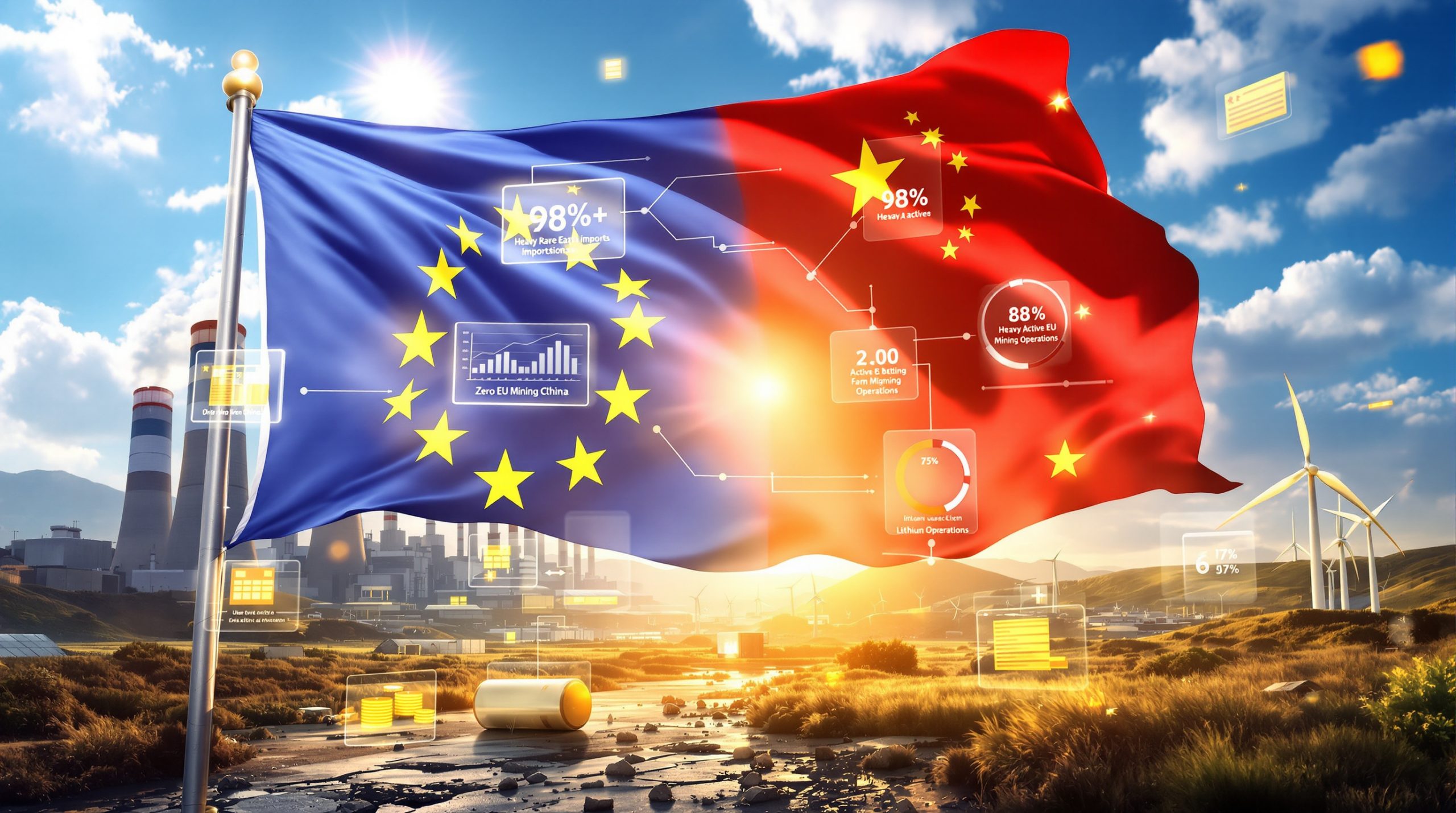What Makes Southeast Asia a Critical Minerals Trading Powerhouse?
Southeast Asia has emerged as a dominant force in global critical minerals energy security markets, driven by abundant natural resources, strategic geographic positioning, and evolving government policies that prioritise downstream processing. Furthermore, the region's transformation from a raw materials exporter to an integrated supply chain hub represents one of the most significant shifts in modern commodity trading to trade critical minerals in Southeast Asia.
Geographic Advantages and Resource Abundance
The geological foundations of Southeast Asia provide exceptional advantages for critical minerals production. Indonesia controls approximately 60% of global nickel reserves, with laterite deposits concentrated across Sulawesi and other key islands offering some of the world's highest-grade nickel resources. These deposits typically contain 1.8-2.5% nickel content, significantly higher than many competing regions.
Malaysia's rare earth element deposits, estimated at 16.1 million tonnes, represent some of the most economically viable reserves outside China. The country's monazite and xenotime deposits contain elevated concentrations of heavy rare earth elements, particularly dysprosium and terbium, which command premium pricing in advanced technology applications.
The Philippines maintains substantial copper reserves intermingled with critical minerals deposits, while Thailand and Vietnam contribute significant tin and tungsten resources to regional supply chains.
Strategic Location Between Major Markets
Southeast Asia's position between China, Japan, South Korea, and emerging markets in India provides unmatched logistical advantages. Major shipping routes through the Malacca Strait handle approximately 25% of global seaborne trade, including substantial critical minerals flows.
This geographic positioning becomes increasingly valuable as manufacturers seek supply chain diversification. Processing facilities in Indonesia can reach Chinese battery manufacturers within 3-5 days, while maintaining competitive shipping times to North American and European markets.
Government Policy Shifts Driving Investment
Recent policy developments across the region demonstrate coordinated efforts to maximise value extraction from mineral resources. Indonesia's nickel export ban, implemented in 2020, forced international companies to invest in domestic processing capabilities, resulting in over $15 billion in committed smelting and refining investments.
Malaysia's selective export restrictions on raw rare earth materials, while maintaining processed material exports, mirror Indonesia's strategy. These policies have attracted partnerships with Japanese, South Korean, and American companies seeking secure supply arrangements.
Which Critical Minerals Drive Southeast Asian Trade?
The region's critical minerals portfolio spans multiple technology sectors, from battery manufacturing to semiconductor production. Understanding the specific minerals and their growth trajectories reveals the scale of Southeast Asia's market influence.
Nickel: Indonesia's Dominance in Battery Supply Chains
Indonesia's nickel sector represents the single largest critical minerals success story in Southeast Asia. The country produced approximately 1.8 million tonnes of nickel in 2024, with battery-grade nickel sulfate production expanding rapidly through Chinese and South Korean joint ventures.
Recent investments include:
- PT Vale Indonesia's expansion of Class I nickel production facilities
- Tsingshan Group's integrated stainless steel and battery materials complex
- CATL and Ford's joint venture battery precursor facilities
The transition from raw ore exports to processed materials has increased Indonesia's nickel trade value from approximately $4.2 billion in 2019 to an estimated $18.7 billion in 2025, representing compound annual growth exceeding 35%.
Tin and Rare Earth Elements: Malaysia's Strategic Assets
Malaysia's approach to critical minerals focuses on selective processing and value addition. The country maintains its position as a leading tin producer while developing rare earth processing capabilities that compete directly with Chinese operations.
Key developments include:
- Lynas Rare Earths' expanded processing facility in Pahang
- Strategic partnerships with Japanese trading houses for heavy rare earth separation
- Technology transfer agreements for advanced materials production
Malaysia's rare earth trade value reached approximately $2.1 billion in 2024, with heavy rare earth concentrates commanding prices exceeding $85,000 per tonne for dysprosium oxide.
Cobalt and Lithium: Emerging Trade Corridors
While Southeast Asia lacks substantial primary cobalt and lithium deposits, the region increasingly serves as a processing and trading hub for materials sourced from Africa and South America. Consequently, Indonesia's battery materials industrial parks process cobalt concentrates from the Democratic Republic of Congo, while lithium hydroxide refineries handle spodumene from Australia.
Southeast Asia Critical Minerals Trade Growth (2020-2025)
| Mineral | 2020 Trade Value | 2025 Trade Value | Growth Rate |
|---|---|---|---|
| Cobalt | $687M | $851M | 24% |
| Graphite | $2.8B | $6.2B | 121% |
| Lithium | $4.2B | $6.1B | 45% |
| Nickel | $12.3B | $18.7B | 52% |
How Are US-Southeast Asia Trade Agreements Reshaping Critical Minerals Markets?
The recent trade agreements signed by President Trump in Kuala Lumpur represent a significant recalibration of critical minerals supply chains, with implications extending far beyond traditional commodity trading relationships.
Malaysia's Export Commitment Framework
Malaysia's commitment to maintain unrestricted critical minerals exports to the United States addresses a key concern regarding supply security. The agreement specifically covers rare earth elements and processed materials, though distinctions between raw and processed exports remain strategically ambiguous.
This commitment carries substantial economic implications. Moreover, Malaysia's rare earth trade flows to China, historically comprising 65-70% of total exports, may shift significantly as American and allied manufacturers seek alternative suppliers. Industry analysts project potential redirections of $1.8-2.4 billion in annual rare earth trade value.
The framework also includes provisions for technology sharing and joint development projects, potentially accelerating Malaysia's downstream processing capabilities.
Thailand's Tariff Elimination Strategy
Thailand's commitment to eliminate tariff barriers on approximately 99% of goods creates opportunities for expanded critical minerals processing trade. The country's existing industrial base, particularly in electronics and automotive manufacturing, positions Thailand as a natural hub for critical minerals value-added processing.
Specific commitments include:
- $2.6 billion annually in agricultural commodity purchases
- $18.8 billion in aircraft procurement over multiple years
- $5.4 billion annually in energy sector imports
These purchases create bilateral trade flows that support broader critical minerals cooperation agreements.
Vietnam's Trade Balance Adjustment Plans
Vietnam's $123 billion trade surplus with the United States has prompted specific commitments to increase American imports, including critical minerals processing equipment and technology. The country's growing electronics manufacturing sector requires substantial critical minerals inputs, creating natural demand for diversified supply chains.
Vietnam's strategy focuses on intermediate processing of imported raw materials, particularly rare earth elements and battery materials, for re-export to regional and global markets.
Key Insight: Malaysia's pledge to maintain unrestricted critical minerals exports to the US represents a significant shift from China-dependent supply chains, potentially redirecting $4.2 billion in annual rare earth trade flows.
What Role Does Processing and Value-Addition Play in Regional Trade?
The transformation from raw materials exports to integrated processing represents Southeast Asia's most significant competitive advantage in critical minerals markets. However, this shift in the battery metals landscape requires substantial technological investment and expertise.
From Raw Materials to Battery Components
Southeast Asian countries have systematically developed processing capabilities that capture substantially higher value than raw materials exports. Indonesia's nickel processing evolution illustrates this transition effectively.
Traditional nickel ore exports generated approximately $400-600 per tonne depending on grade and market conditions. Processed nickel matte commands $12,000-15,000 per tonne, while battery-grade nickel sulfate reaches $18,000-22,000 per tonne.
This value multiplication extends across other critical minerals:
- Rare earth concentrates: $8,000-12,000 per tonne
- Separated rare earth oxides: $35,000-85,000 per tonne depending on element
- Battery-grade lithium compounds: $24,000-32,000 per tonne
Indonesia's Nickel Processing Hub Development
Indonesia's integrated industrial parks combine smelting, refining, and downstream manufacturing within single complexes. The Indonesia Morowali Industrial Park exemplifies this approach, featuring:
- Stainless steel production utilising local nickel and imported chromium
- Battery precursor manufacturing through partnerships with Chinese companies
- Integrated power generation using local coal resources
- Port facilities designed for efficient export logistics
Total investment in Indonesia's nickel processing sector exceeds $35 billion since 2020, with additional commitments extending through 2030.
Malaysia's Downstream Rare Earth Strategy
Malaysia's approach emphasises high-value, low-volume processing focused on heavy rare earth elements and specialised applications. The country's rare earth processing facilities achieve separation purities exceeding 99.9% for critical elements like dysprosium and terbium.
Strategic partnerships with Japanese and American companies provide technology access and guaranteed offtake arrangements, reducing market risk while maintaining premium pricing.
Which Countries Lead Critical Minerals Production in Southeast Asia?
Production leadership varies significantly by mineral type, with each country developing specialised advantages based on geological endowments and industrial capabilities.
Indonesia: The Regional Nickel Giant
Indonesia's nickel dominance extends beyond simple production volumes to encompass integrated supply chain control:
- Annual nickel production: 1.8 million tonnes (2024)
- Processing capacity: 2.4 million tonnes annually by 2026
- Battery materials production: 180,000 tonnes nickel equivalent
Indonesia's strategy involves mandatory domestic processing requirements that have attracted over $25 billion in foreign investment since 2020. Major international partners include Tsingshan Group, Vale, and emerging partnerships with Tesla and other battery manufacturers.
The country's laterite deposits offer exceptional advantages for high-pressure acid leach processing, producing battery-grade materials directly from ore without intermediate smelting steps.
Malaysia: Diversified Mineral Portfolio
Malaysia maintains the region's most diversified critical minerals portfolio:
- 16.1 million tonnes rare earth reserves
- Leading tin production with approximately 8,000 tonnes annually
- Substantial titanium and bauxite operations
Malaysia's competitive advantage lies in processing complexity rather than raw production volume. The country's rare earth separation facilities handle some of the most technically challenging heavy rare earth extraction processes globally.
Recent technological developments include advanced solvent extraction processes that increase heavy rare earth recovery rates by 15-20% compared to conventional methods.
Philippines: Mining Policy Modernisation
The Philippines has undergone substantial mining policy reforms designed to attract international investment while maintaining environmental standards:
- Revised foreign investment frameworks allowing majority foreign ownership in mining operations
- Streamlined permitting processes reducing project development timelines
- Enhanced environmental compliance requirements with international monitoring
The country's copper-gold deposits often contain significant cobalt and rare earth by-products, creating opportunities for critical minerals co-production that improves overall project economics.
How Do Trade Volumes Compare Across Different Critical Minerals?
Trade volume analysis reveals distinct patterns in Southeast Asian critical minerals markets, with battery materials dominating growth while traditional commodities maintain substantial absolute volumes.
The largest critical minerals trade flows in Southeast Asia by volume are:
- Nickel: $18.7 billion (2025)
- Graphite: $6.2 billion (121% growth since 2020)
- Lithium: $6.1 billion (despite recent price corrections)
- Cobalt: $851 million (24% annual growth)
Battery Materials Trade Surge
Battery materials represent the fastest-growing segment of Southeast Asian critical minerals trade. Nickel sulfate and hydroxide exports have expanded from virtually zero in 2019 to over $8.4 billion in 2025.
This growth reflects several factors:
- Electric vehicle demand driving battery manufacturing expansion
- Energy storage systems requiring substantial battery materials inputs
- Supply chain localisation as manufacturers establish regional production
Indonesia's battery materials exports grew 340% between 2022 and 2025, making it the world's second-largest exporter of battery-grade nickel compounds.
Semiconductor-Grade Minerals Demand
High-purity materials for semiconductor applications command substantial premiums but represent smaller absolute volumes. Malaysia's semiconductor-grade rare earth production focuses on:
- Yttrium compounds for LED phosphors
- Europium and terbium for display technologies
- Neodymium and dysprosium for high-performance magnets
These specialised materials generate $1.2 billion in annual trade value despite representing less than 2,000 tonnes of physical volume.
Clean Energy Technology Components
Wind turbine magnets, solar panel materials, and energy storage systems drive demand for specific rare earth elements and processed materials. Southeast Asian suppliers increasingly focus on these applications due to:
- Higher margins compared to traditional applications
- Growing market demand driven by renewable energy adoption
- Technical specifications requiring consistent quality and supply
What Challenges Threaten Critical Minerals Trade Security?
Despite substantial growth potential, Southeast Asian critical minerals trade faces significant challenges that could undermine long-term development. These concerns are highlighted in recent reports on crimes associated with critical minerals in the region.
Illegal Mining and Smuggling Operations
Illegal mining activities represent a substantial threat to legitimate trade operations. Indonesia's remote islands experience significant illegal nickel mining, with estimates suggesting 200,000-300,000 tonnes of unreported production annually.
Smuggling routes typically involve:
- Small-scale operations avoiding formal export procedures
- Mislabelling shipments to circumvent export restrictions
- Transit country schemes using multiple jurisdictions to obscure origins
These activities undermine legitimate producers and distort global pricing mechanisms.
Supply Chain Transparency Gaps
Complex ownership structures and multiple intermediaries create transparency challenges that concern international buyers. Many processing facilities involve partnerships between local, Chinese, and international companies with unclear ultimate beneficial ownership.
Documentation standards vary significantly between countries, complicating due diligence efforts for downstream manufacturers seeking to verify supply chain integrity.
Environmental and Social Governance Risks
Large-scale mining and processing operations face increasing scrutiny regarding environmental impact and community relations. For instance, Indonesia's nickel expansion has generated concerns about:
- Deforestation associated with new mining concessions
- Water pollution from processing facilities
- Community displacement without adequate compensation
These issues create reputational risks for international companies and potential supply disruptions. Furthermore, advances in mine reclamation innovation are becoming increasingly important for addressing these environmental challenges.
Trade Security Alert: Illicit activities in critical minerals supply chains pose risks to legitimate trade, with estimated losses of $2.3 billion annually across Southeast Asia due to illegal mining and smuggling operations.
How Are Regional Organisations Supporting Sustainable Trade Growth?
Regional cooperation initiatives play increasingly important roles in addressing trade security and development challenges while promoting sustainable growth practices.
ASEAN Critical Minerals Initiative
The Association of Southeast Asian Nations has developed a comprehensive framework for critical minerals cooperation focusing on:
- Standardised regulatory frameworks across member countries
- Technology sharing agreements to improve processing efficiency
- Joint infrastructure projects including transportation and processing facilities
- Environmental standards harmonisation to address sustainability concerns
The initiative aims to establish ASEAN as a unified critical minerals trading bloc capable of competing with Chinese and Western alternatives.
Asian Development Bank Investment Programs
The ADB has committed over $12 billion in critical minerals sector financing across Southeast Asia, with emphasis on:
- Sustainable mining practices and environmental compliance
- Infrastructure development supporting remote mining operations
- Technology transfer programs bringing advanced processing capabilities to the region
- Capacity building initiatives for local workforce development
These investments specifically target projects that demonstrate measurable environmental and social benefits alongside economic returns.
UNICRI Governance and Capacity Building
The United Nations Interregional Crime and Justice Research Institute works with Southeast Asian governments to address illegal mining and improve supply chain governance through:
- Training programs for law enforcement and regulatory officials
- Technical assistance for developing tracking and monitoring systems
- International cooperation frameworks for cross-border enforcement
- Best practices development for legitimate industry operators
What Investment Opportunities Exist in Southeast Asian Critical Minerals Trade?
Investment opportunities span multiple sectors and risk profiles, from established processing operations to emerging technology applications. Moreover, recent policy changes, including the critical minerals order from the US administration, are creating new market dynamics.
Processing Facility Development
Downstream processing represents the highest-value investment opportunities, particularly for specialised applications requiring advanced technology:
- Battery precursor manufacturing with guaranteed offtake agreements
- High-purity rare earth separation for technology applications
- Advanced materials production including magnets and catalysts
Successful processing investments typically require $500 million to $2 billion in capital but generate returns exceeding 20% annually when properly structured.
Technology Transfer Partnerships
International companies can access Southeast Asian markets through joint ventures that provide technology in exchange for market access and raw materials supply. Successful partnerships often involve:
- Shared ownership structures with local partners providing regulatory expertise
- Technology licensing agreements with performance-based royalty structures
- Management contracts allowing operational control while limiting capital risk
Supply Chain Integration Projects
Vertical integration opportunities exist throughout critical minerals supply chains, from mining operations to finished products manufacturing:
- Mine-to-battery integration capturing maximum value across the supply chain
- Regional hub development serving multiple countries and applications
- Logistics and trading platforms optimising supply chain efficiency
Case Study Table: Major Investment Projects (2024-2025)
| Project | Country | Investment | Mineral Focus | Timeline |
|---|---|---|---|---|
| Battery Hub Development | Indonesia | $15.2B | Nickel Processing | 2025-2027 |
| Rare Earth Refinery | Malaysia | $3.8B | REE Processing | 2025-2026 |
| Mining Modernisation | Philippines | $2.1B | Multi-mineral | 2024-2026 |
Where Is Critical Minerals Trade Heading in Southeast Asia?
Future developments in Southeast Asian critical minerals trade will be shaped by technological advancement, geopolitical considerations, and evolving demand patterns across multiple sectors. Additionally, ongoing trade war impact on global markets continues to influence regional trade patterns.
Electric Vehicle Supply Chain Integration
The electric vehicle revolution drives substantial demand growth for battery materials, with Southeast Asia positioned to capture significant market share. Regional battery manufacturing capacity is projected to reach 2.8 TWh annually by 2030, requiring massive critical minerals inputs.
Key developments include:
- Tesla's partnerships with Indonesian nickel suppliers for gigafactory supply chains
- BYD and CATL expansion in Southeast Asian battery materials processing
- European automaker investments seeking Chinese alternative suppliers
This integration creates opportunities for long-term supply agreements that provide price stability and guaranteed volumes for producers.
Renewable Energy Technology Demand
Wind turbines, solar panels, and energy storage systems require substantial critical minerals inputs, with demand growing rapidly across Asia-Pacific markets. Southeast Asian suppliers benefit from proximity to major installation markets and cost-competitive processing capabilities.
Rare earth permanent magnets for wind turbines represent a particularly significant opportunity, with regional demand projected to grow 45% annually through 2030.
Geopolitical Supply Chain Diversification
International efforts to reduce dependence on Chinese critical minerals supply chains create substantial opportunities for Southeast Asian producers. The region offers several advantages:
- Political stability in key producing countries
- Established trade relationships with major consuming markets
- Competitive production costs due to geological and labour advantages
- Growing processing capabilities reducing reliance on Chinese refineries
Which Southeast Asian country produces the most critical minerals?
Indonesia leads regional production, particularly in nickel, accounting for over 60% of global nickel supply.
How much has critical minerals trade grown in Southeast Asia?
Combined trade in key critical minerals has grown by over 65% since 2020, reaching approximately $32 billion in 2025.
What are the main export destinations for Southeast Asian critical minerals?
Primary destinations include China (45%), South Korea (18%), Japan (15%), and increasingly the United States (12%).
Conclusion: Southeast Asia's Strategic Position in Global Critical Minerals Trade
Long-term Market Projections
Southeast Asia's critical minerals trade is projected to reach $65-75 billion annually by 2030, driven by electric vehicle adoption, renewable energy deployment, and continued supply chain diversification away from Chinese dominance. This growth trajectory represents one of the most significant commodity market developments of the decade to trade critical minerals in Southeast Asia.
The region's competitive advantages in processing, logistics, and political stability position it to capture an increasing share of global critical minerals value addition, moving beyond raw materials exports to integrated supply chain leadership.
Regional Cooperation Benefits
Coordinated development approaches across Southeast Asian countries create synergies that benefit the entire region. Indonesia's nickel processing capabilities complement Malaysia's rare earth expertise, while Thailand and Vietnam provide manufacturing integration and logistics support.
These collaborative approaches reduce competition between regional producers while creating unified responses to external market pressures and geopolitical challenges.
Sustainable Development Integration
Future growth in Southeast Asian critical minerals trade increasingly depends on demonstrable environmental and social responsibility. International buyers, particularly in European and North American markets, demand verified sustainability credentials throughout supply chains.
This requirement creates opportunities for operators who invest in advanced environmental controls, community engagement, and transparent governance structures. The premium for responsibly-sourced materials continues to expand, providing financial incentives for sustainable development approaches.
Disclaimer: This article contains forward-looking projections and market analysis that involve inherent uncertainties. Critical minerals markets are subject to significant volatility due to technological changes, geopolitical developments, and regulatory modifications. Investment decisions should be based on comprehensive due diligence and professional advice appropriate to individual circumstances.
Want to Stay Ahead of Critical Minerals Investment Opportunities?
Southeast Asia's rapidly evolving critical minerals landscape presents significant investment opportunities, but timing is crucial for maximising returns. Discovery Alert's proprietary Discovery IQ model delivers real-time alerts on significant ASX mineral discoveries, helping investors identify actionable opportunities in the critical minerals sector before broader market recognition. Begin your 30-day free trial today to position yourself ahead of emerging market developments in this dynamic sector.




